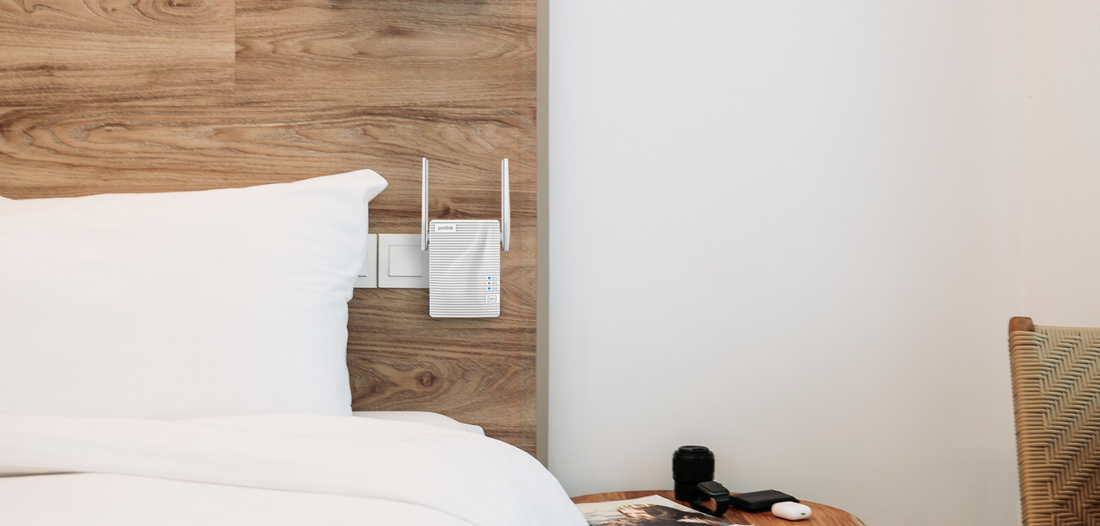What are the different modes on your Wi-Fi range extender and how and when do you use them?
There’s always that one particular room in the house that has weak to nonexistent Wi-Fi signal while every other room gets a full signal. And if that said room just happens to be your bedroom, it makes you wonder - while having a spacious room with a scenic view is great…. Should you move into the smaller room with a better Wi-Fi signal? If you find yourself in such a predicament, stress no further as there is a simple solution to it all - a WiFi range extender!

If you have never heard of a Wi-Fi range extender, how it works is that it wirelessly rebroadcasts the signal from your router to expand its coverage. Think of it as a bridge, helping your internet connection pass from the point of your router to other areas which may have limited connectivity. Say goodbye to days of having to sit near the router just to stream your favourite show or play an online game, and welcome high-speed internet all around the house.
The benefits of Wi-Fi extenders are significant, allowing you to eliminate dead spots around your working or living area and improve overall network speed. To top it all off, it’s the cost-efficient alternative to purchasing multiple routers and placing them throughout your space too.
While purchasing a Wi-Fi extender is the no-brainer solution to your connection issues, the different modes it offers and how you put it to use will greatly affect the outcome of your Wi-Fi connection. If you have poked around its settings, you may have noticed that you can set it to one out of three different modes: “Repeater”, “Access Point”, or “Router”. All three modes are equally useful and can help enhance your networking setup in different ways. To better understand which mode you should use for your situation, let’s go through the different modes offered, what it does and when you should use them.
Repeater mode
The repeater mode helps you extend Wi-Fi coverage over a greater distance wirelessly. The Wi-Fi extender receives the signal from the router and creates a new signal based on the originating network, thus extending the range without being connected via cable. With the repeater mode, you don’t need a lengthy Ethernet cable connected to the main internet source for your network to be running. However, it’s wireless nature of communicating with the main source of the internet makes it susceptible to physical obstacles.
It is recommended to use the repeater mode when you have a large, unobstructed space that requires a bridge to extend your Wi-Fi range without the use of an Ethernet cable.
Access point mode
The access point mode works the same way in that it helps extend Wi-Fi coverage to your workspace or home, too. However, it can only be placed at a fixed distance as it requires an Ethernet cable to be connected between the Wi-Fi extender and the main internet source. In return, the Ethernet cable ensures you get the best possible speeds between the access point and the main internet source, giving you peace of mind as you jump into that zoom call.
With the help of the Ethernet cable, you get direct input from the router and your network connection can penetrate through even a concrete wall that’s possibly blocking Wi-Fi connections. Simply connect the Wi-Fi extender to the main internet source, place it on the other side of the wall, and put it in Access Point mode to enjoy full internet speed from your router.
Router mode
With the router mode, your Wi-Fi extender does the same in projecting Wi-Fi signals from the original internet source to the location it’s being placed at - but this time, the internet connection, while reliant on the main source, is an independent network. This means that with your Wi-Fi extender mimicking the role of an actual router, you get to tweak settings such as parental controls for kids devices, restricting specific websites, schedule Wi-Fi pauses to limit internet consumption, and so on.
This mode is extremely useful in cases where you are traveling or enjoying a staycation at a hotel with limited or low-speed Wi-Fi connection and don’t want to explode your phone bill costs by using your data connection to replay baby videos to soothe your child. The Prolink PEN1201 Wi-Fi extender allows you to plug the device into a socket and easily connect the Ethernet cable into the device to create an independent and stronger network in your room. With the Ethernet cable plugged in, the Wi-Fi access that the hotel provided will pale in comparison to your effortlessly upgraded network speed.

While we’ve discussed how advantageous Wi-Fi extenders can be, do pay attention to your device settings when you’re using one. Your phone or other gadgets may remain connected to your main source of internet - defeating the purpose of installing your Wi-Fi extender.

If the idea of not needing to sacrifice your Wi-Fi connection while you’re out in the balcony trying to enjoy watching a video in serenity piques you, search no further and browse our range of Wi-Fi extenders below to find what suits your situation best.
Shop: Wi-Fi Extender | PEN1201
Shop: Dual-band Wi-Fi AC1200 Extender | DH-5201
